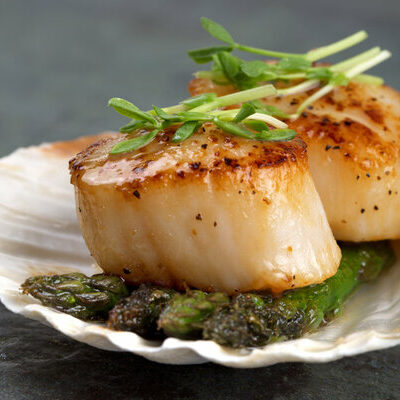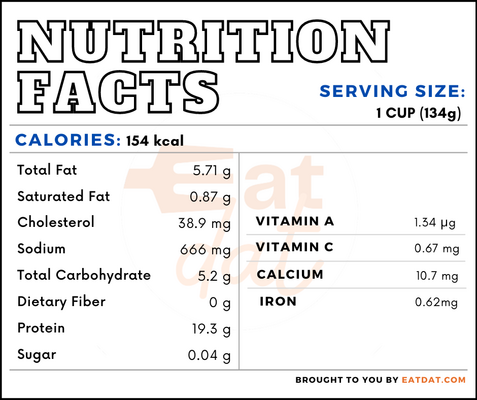
Scallops
What are Scallops?
Scallops fall under the category of seafood and belong to the Pectinidae family of marine bivalve mollusks, otherwise known as clams. They are a type of shellfish with beautiful and brightly colored, fan-shaped shells with radiating and fluted ornamentation. Both freshwater (bay) and seawater types are used as food. The edible part of this creature is the white flesh between the shell cover.
- They have a sweet taste with hints of brine.
- Sea scallops are better suited for searing or grilling due to their chewy texture, while bay varieties can be used for other purposes.
Some of the most popular scallop brands available on the market are:
- Seafood
- Alli & Rose LLC
- Greenlike
- Bestliving
- Charleston Seafood
- Sea Best
- WFH
- Nestlady
- Grand Gift
- Lungcha
Origin of scallops
These have been in existence for 300 million years. Furthermore, they have been consumed by humans since prehistoric times. Recipes for scallops have been found from ancient Rome, ancient China, and other ancient coastal civilizations. In the 1600s, early New Englanders weren’t very fond of scallops; however, the desire for this seafood would eventually grow in time. By 1846, recipes for this food were appearing in American cookbooks as locals began to try and experiment with scallops.
Nutrition
Nutritional profile for scallops (1 cup, raw):

In addition, scallops contain magnesium, phosphorus, potassium, selenium, folate, choline, and vitamin K. Also, they contain antioxidants. Regular consumption of this seafood may help in preventing obesity and related diseases. This seafood assists in improving the HDL and improves the plasma lipid profile.
Commercial production
The main exporters of scallops are the UK, Canada, Japan, the USA, and South Korea. They are sold either wet packed or dry packed. Wet versions are treated with sodium tripolyphosphate (STP) to increase their shelf life. This tends to loosen the structure of the proteins, which then suck up moisture and bloat up. Dry varieties are untreated and have a much shorter shelf life. However, dry scallops have a higher quality, flavor, and can be cooked easily.
In order to prevent shellfish contamination such as heavy metals, toxins, and microbiological contaminants, it is advised that the viscera should be removed and only the adductor muscles consumed. Other ways to ensure healthy cooking is to clean the shells before cooking, purchasing from reliable sources, cooking thoroughly and discarding the liquid, and eating small portions. According to the FDA, scallops that are safe to eat should be clear with a pearl-like color and minimal odor.
Scallops recipes
Most varieties of scallops only need four minutes to cook. Overcooking will spoil them and give them a rubbery texture. They may be fried, baked, grilled, or broiled. However, they are popularly prepared by pan-searing them in butter and served with lemon for added flavor. Here are some recipes to try:
- Lemon Butter Scallops
- Creamy Scallop Pasta
- Coquilles St-Jacques
- Sixi Scallops
- Glass Noodles
- Laksa
- Toshi’s Noodles
- Gulai
- Kinilaw na Scallops
FDA regulations
The FDA classifies scallops as molluscan shellfish. The organization defines them as any edible species of fresh or frozen oysters, clams, mussels, or scallops, or edible portions of such species, except when the product consists entirely of the shucked adductor muscle. In addition, the FWC regulates the harvesting of scallops, and designates the regions where they can be farmed and the legal farming seasons. Also, it specifies the amount to be harvested by one individual or company over a specific period.
References
Tastesen, Hanne Sørup et al. “Scallop protein with endogenous high taurine and glycine content prevents high-fat, high-sucrose-induced obesity and improves plasma lipid profile in male C57BL/6J mice.” Amino acids vol. 46,7 (2014): 1659-71. doi:10.1007/s00726-014-1715-1, https://www.ncbi.nlm.nih.gov/pmc/articles/PMC4055845/
Lynne Olver, FAQs: fish & shellfish, Food Timeline, http://www.foodtimeline.org/foodlobster.html
Hosomi, Ryota et al. “Seafood consumption and components for health.” Global journal of health science vol. 4,3 72-86. 28 Apr. 2012, doi:10.5539/gjhs.v4n3p72, https://www.ncbi.nlm.nih.gov/pmc/articles/PMC4776937/
